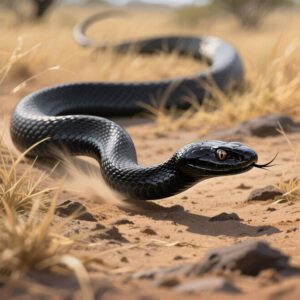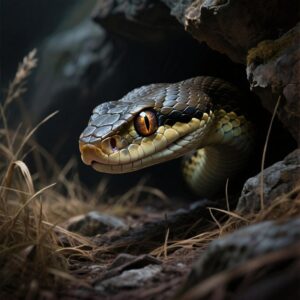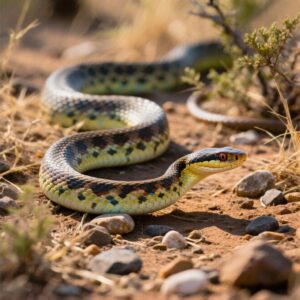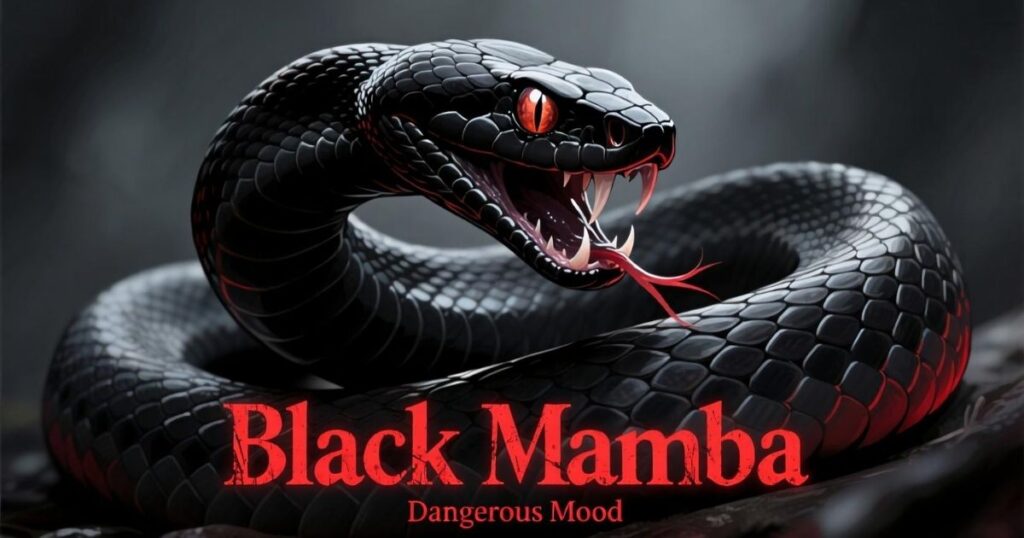Black mamba is one of the most feared snakes in the world. The black mamba snake is fast, smart, and very dangerous. It lives in parts of Africa, from savannahs to forests. People often ask, how fast can a black mamba kill you? Its bite can be deadly in less than 30 minutes without treatment. The black mamba venom attacks the nervous system and the heart.
Black mambas are not really black on the outside. They have a gray or brown body with a black mouth, which is why they are called the black mamba. These snakes can move at amazing speed, reaching up to 12 miles per hour. They are shy and avoid people, but will defend themselves if threatened. Learning about the black mamba can help people stay safe. Always respect wild snakes and never try to catch or handle them.
Black Mamba Myths

Many people believe the black mamba will chase humans for long distances. This is a myth. The black mamba is shy and tries to escape when it sees danger. While it’s fast and powerful, the black mamba only attacks when it feels cornered or threatened.
Another myth says the black mamba kills instantly. In reality, death is not instant. The black mamba venom works quickly, but antivenin can save lives if given in time. Many people survive bites thanks to quick medical care. The black mamba is dangerous, but not unstoppable.
Some believe the black mamba is pure black in color. This is false. The snake’s body is gray or brown, with a black mouth. This dark mouth is the reason it’s called the black mamba. Knowing the truth helps protect both people and these incredible snakes.
What is a Black Mamba?

The black mamba is a large, fast, and highly venomous snake found in Africa. Despite its name, it isn’t black on the outside but has a dark mouth. It can grow over 14 feet long. The black mamba snake is one of the fastest snakes in the world.
A female black mamba lays 10 to 25 eggs at a time in termite mounds or hollow tree trunks. The hatchlings are born fully independent and already have potent black mamba venom. They grow quickly and can survive on their own from birth. This makes them strong survivors in the wild.
The black mamba can live for about 11 years in the wild and even longer in captivity. Its speed, deadly venom, and smart hunting skills make it a dangerous predator. Knowing how fast can a black mamba kill you shows why it’s feared and respected in Africa.
Read More: King Cobra Fact Sheet
Diet:
The diet of the black mamba mainly includes small mammals, birds, and sometimes reptiles. They are skilled hunters, using their incredible speed to strike quickly. Once they inject venom, they wait for the prey to weaken before swallowing it whole. Hunting mostly happens during the day.
Black mambas rely on their excellent eyesight to spot movement from a distance. They target creatures like squirrels, rats, and small birds. Their flexible jaws allow them to consume animals much larger than their head. This efficient feeding style helps them stay strong and active in the wild.
Habitat:
The habitat of the black mamba spans across sub-Saharan Africa, where it thrives in savannas, rocky hills, and open woodlands. It prefers warm, dry areas with plenty of hiding spots like termite mounds or hollow trees, allowing it to hunt and stay safe from predators.
Geography:
The geography of the black mamba covers parts of sub-Saharan Africa, where it thrives in savannas, rocky hills, and open woodlands. This snake prefers warm, dry habitats with plenty of hiding spots. Its range spans countries like South Africa, Kenya, and Ethiopia, making it widely distributed across the continent.
Threats:
The black mamba faces threats mainly from habitat loss, hunting, and fear-driven killings. Expanding farms and towns destroy their natural homes. People often kill them on sight due to their deadly reputation. Despite being dangerous, they play an important role in controlling rodent populations in their ecosystem.
Social Structure:
Black mambas are mostly solitary creatures, avoiding others except during mating season. They prefer to live alone in their chosen territory, often returning to the same resting spots. This solitary lifestyle helps reduce conflict and competition, ensuring they can hunt and rest without disturbance.
These snakes are highly territorial, especially males. They use their speed and agility to patrol and defend their areas. While they don’t form social groups, they may tolerate nearby snakes if resources are plentiful. However, aggressive encounters can occur when territories overlap, particularly during the breeding season.
During mating season, males display a unique social behavior. They engage in “combat dances,” where they wrestle without biting to establish dominance. The winner gains the right to mate, while the loser retreats. This ritual avoids serious injury, allowing both snakes to survive for future encounters.
Outside of mating, black mambas show no desire for companionship. They rely on their keen senses and speed to navigate life alone. This solitary nature makes them efficient hunters and reduces the risk of predators targeting groups. In the wild, independence is their best strategy for survival.
How Long is a Black Mamba?
The black mamba is one of the longest venomous snakes in Africa. On average, it grows between 8 and 10 feet. Some can reach over 14 feet, making them very impressive. Their long, slender body helps them move quickly and strike with deadly accuracy.
Young black mambas start smaller but grow fast. Their size gives them an advantage in hunting and defending themselves. A large black mamba can scare predators away just by showing its full length. Despite their size, they can hide well in termite mounds, hollow trees, and thick grass.
What Does Black Mamba Venom Do?
Black mamba venom is a deadly mix of neurotoxins and cardio toxins. It attacks the nervous system, stopping signals between the brain and muscles. This can cause slurred speech, blurred vision, and paralysis. Without quick treatment, it can shut down the respiratory system and heart within minutes.
The venom spreads fast through the bloodstream. Victims may feel drowsy, weak, and have tunnel vision. Breathing becomes harder as more muscle groups stop working. Antivenin is the only cure, but it must be given quickly. That’s why knowing what black mamba venom does can save lives during snake season.
How Poisonous is a Black Mamba?
The black mamba is one of the most venomous snakes on Earth. Its bite delivers a mix of neurotoxins and cardio toxins. These attack the nervous system and heart within minutes. Without quick treatment, the effects can be deadly. This snake’s venom is strong enough to kill several people.
A single bite from a black mamba can cause slurred speech, blurred vision, drowsiness, and paralysis. The venom quickly enters the bloodstream and shuts down major muscle groups, including those that control breathing. Without antivenin and a respirator, a victim may not survive. This is why it’s so dangerous.
People often ask, “How poisonous is a black mamba?” The truth is, it’s extremely dangerous. In the wild, experts like those in Kruger Park focus on capture and release to protect both people and snakes. Respecting the black mamba is the safest way to avoid deadly encounters.
Snake Season

Snake Season usually starts after the summer rains in many parts of Africa. Warm weather and plenty of food bring snakes, like the black mamba, out of hiding. During this time, they are more active and can be seen hunting or basking in the sun.
In South Africa, snake season often runs from October to April. This is when snakes leave their shelters in termite mounds, hollow tree trunks, and granite hillocks. People visiting parks like Kruger Park should be careful. Carrying a snake first-aid kit can help if you meet dangerous snakes during these warmer months.
Conservation Efforts:
Black mambas face threats from habitat loss, hunting, and fear-driven killing by humans. Conservationists work to protect their natural habitats and reduce unnecessary persecution. Education plays a key role, teaching communities about the snake’s ecological role and why it shouldn’t be destroyed out of fear.
Wildlife organizations support anti-poaching laws and snake relocation programs to keep black mambas safe while protecting people. Research programs study their behavior, population numbers, and threats to develop better conservation strategies. These efforts aim to maintain a balance between human safety and snake survival in shared environments.
Community involvement is essential in black mamba conservation. Locals are trained to identify the species, handle encounters safely, and call experts for removal instead of killing them. By promoting coexistence and respect for nature, these initiatives help ensure black mambas remain a vital part of Africa’s ecosystems.
Kruger Park Snakes

Kruger Park snakes are most active during the warm, wet months from October to April. This is snake season, brought on by summer rains. Visitors may see venomous and non-venomous species, including the black mamba. Rangers often capture and release snakes to keep both wildlife and people safe.
FAQ’S
What is the most dangerous snake in Africa?
The black mamba is considered Africa’s most dangerous snake due to its speed, aggression, and highly toxic venom that can kill quickly without treatment.
How fast can a snake move?
The black mamba can reach speeds up to 12 miles per hour, making it one of the fastest snakes in the world.
Where do these snakes live?
The black mamba lives in savannahs, rocky hills, and forests across sub-Saharan Africa, often hiding in termite mounds or hollow tree trunks.
What happens if you get bitten?
A black mamba bite delivers neurotoxins and cardio toxins that attack the nervous system and heart, causing paralysis, breathing failure, and death without antivenin.
Are they aggressive to humans?
The black mamba usually avoids people, but will strike repeatedly if cornered or threatened, delivering enough venom to kill several humans in one encounter.
Conclusion
The black mamba is one of Africa’s deadliest snakes. It moves fast and has powerful venom. Its bite can cause paralysis and stop your heart if not treated quickly. The black mamba lives in places like termite mounds, hollow tree trunks, and moist savannahs. It usually avoids people but will defend itself if it feels threatened. Knowing how to spot and stay away from this snake is very important, especially during snake season when they are more active.
If bitten by a black mamba, getting antivenin fast is key. Doctors may use a respirator to help breathing. Tourniquets and bandages are part of the snake first-aid kit, but professional help is always needed. Thanks to experts like Danie Pienaar and Marius Golden, many lives have been saved in places like Kruger Park and Hoedspruit. Respect the black mamba’s space, and you’ll stay safe around one of nature’s most amazing creatures.


1 thought on “Black Mamba Facts”